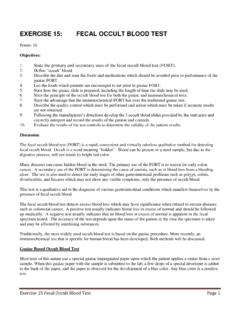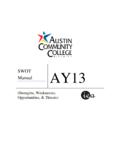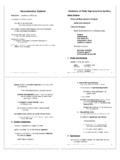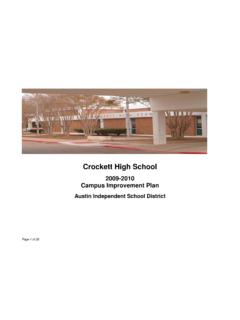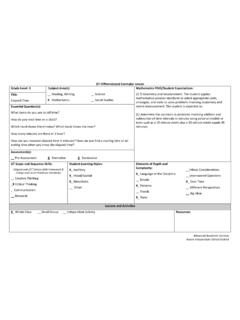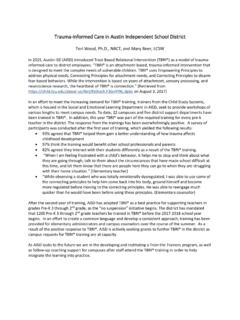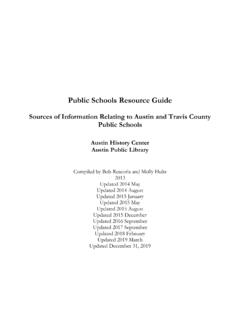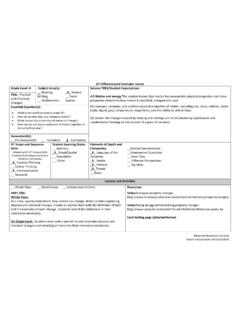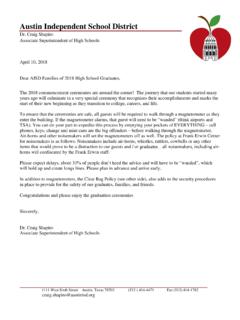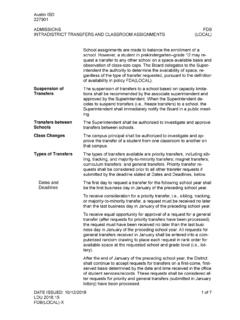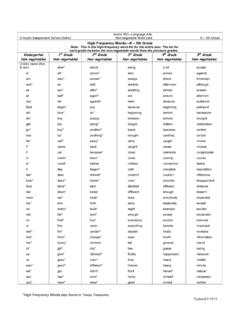Transcription of 1st 20 days of Math - Austin Community College District
1 2009 Austin ISD Getting Started: Establishing Routines & Procedures During the 1st 20 days of math Austin independent school District Department of Curriculum and Instruction Page 1 of 10 Elementary Mathematics Overview: For students, a successful experience with math begins with the basics: how to think like an active mathematician, how to speak mathematically, and how to record and share their thinking. This guide is intended for grades 3-5 but can be used for K-2 with modifications, and may be extended, condensed, or modified according to students needs. As you prepare to implement the 1st 20 days of math during the 90 minutes of math instruction, keep in mind that it will be necessary to be flexible.
2 These 5-15 minute lessons are to be incorporated into the daily lesson. Grade level teams may meet periodically to monitor and adjust progress. Clear statements and clear demonstrations of roles and procedures need to be established. All points and aspects need to be repeated, charts or anchors of support are to be posted and referred to again and again. Goals: The goals of implementing the instructional strategies included in this document are to help students think of themselves as mathematicians who enjoy and actively participate in math ; establish consistent classroom roles, routines and procedures that support teaching and learning; increase rigor by having students explore, express, and better understand mathematical content though process skills (communication, connections, reasoning and proof, representations, and problem solving).
3 Background: Based on the idea of The First 20 days of independent Reading by Fountas & Pinnell, these lessons have been developed to establish the roles, routines and procedures needed for effective mathematics instruction. Principles of Learning are the foundation of this document. All students are told that they are already competent learners and are able to become even better through their persistent use of strategies and by reflecting on their efforts. Criteria for quality and work are explicit, accessible to all students, displayed publicly, and change over time to respond to level of rigor as learning deepens.
4 2009 Austin ISD Getting Started: Establishing Routines & Procedures During the 1st 20 days of math Austin independent school District Department of Curriculum and Instruction Page 2 of 10 Elementary Mathematics Mini Lesson Key Concepts Learning Outcomes Anchors of Support Resources Teacher Notes Day 1 Management: Establish Routines and Procedures for independent and/or Cooperative math Groups Principles of Learning: Clear Expectations Establish student expectations during Mathematics instruction. Discuss the importance of Anchors of Support such as criteria charts, student work criteria and instructional aides.
5 Students understand and learn that information will be posted around the classroom for them to use to make their work better, to support their learning and to help them review concepts as they are learned. Students identify criteria to create a Good Work chart to post. Post Good Work process chart to which students can refer. (A good work chart should have less than 6 criteria to be effective.) Example: Stay on Task Speak/write mathematically Be an active listener and participant. Respect and organize math materials appropriately. Chart paper Markers Before the lesson, make sure to discuss routines and procedures with the students.
6 This is a good time to have students talk about what good students work should look like and then create the criteria chart using students ideas. Day 2 Management: How and why do mathematicians use tools? Mathematicians use math tools to help solve problems. Discuss mathematical tools and how they are to be used and stored. Students become familiar with the math tools in the classroom. Add notes to the Good Work chart about placing materials in their proper storage containers and location after use. In part 2 of each enVision math lesson, Develop the Concept: Interactive, students use manipulatives.
7 This is a good time to establish & reinforce the how and why of using mathematical tools. 2009 Austin ISD Getting Started: Establishing Routines & Procedures During the 1st 20 days of math Austin independent school District Department of Curriculum and Instruction Page 3 of 10 Elementary Mathematics Mini Lesson Key Concepts Learning Outcomes Anchors of Support Resources Teacher Notes Day 3 Problem Solving: Mathematicians solve problems using a process. There is a process involved when solving problems. Introduce Polya s 4 Step Problem Solving Model. Students understand the importance of problem solving every day.
8 Students will learn that there is a process involved when solving problems. Develop and post a process chart of the mathematician s, Polya s, 4-Step Problem Solving Model. The four steps are: Understand the problem, Devise a plan, Carry out the plan, and Look back. There are many record keeping & pneumonic devices that follow this model. The selection of one to use campus-wide is recommended. Problem Solving Model Chart paper Each day students will engage in problem solving during 90 minute math block (Problem of the Day and/or 2 Develop the Concept: Visual). Post the chart on the wall in student- friendly language.
9 Day 4 Writing/Representations in math Mathematicians write about their thinking as a way to process information Representation is a Process Skill. Mathematicians use and record mathematical representations to interpret and model everyday life activities. Introduce Interactive math Journals. Students understand that they are expected to write about their mathematical thinking on a daily basis. Students understand that writing about their thinking is a way to represent mathematical concepts. Students understand that the journal is a mathematical tool. On a chart, post a model of the left and right side of math interactive journal (use science journal as a model).
10 Post the Essential Understanding Question from the enVision lesson. Student journal Model of journal Sentence strip for Essential Understanding Question At the end of the lesson, use the Essential Understanding Question as a journal prompt. Have students write about their understanding. Day 5 Mathematics is a In a math Students understand Post Word Bank Vocabulary words As you 2009 Austin ISD Getting Started: Establishing Routines & Procedures During the 1st 20 days of math Austin independent school District Department of Curriculum and Instruction Page 4 of 10 Elementary Mathematics Mini Lesson Key Concepts Learning Outcomes Anchors of Support Resources Teacher Notes Language: classroom, specialized language is used.





